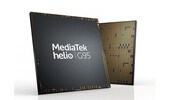Unisoc T7255 (T616) vs Mediatek Helio G99 vs Mediatek Helio G95
Unisoc T7255 (T616)
► remove from comparison
The Unisoc T7255 (formerly Unisoc T616) is an entry level octa core SoC with two fast ARM Cortex A75 cores at up to 2 GHz and six power efficient ARM Cortex A55 cores at up to 1.8 GHz. The SoC further includes an LTE modem (TDD-LTE, FDD-LTE, TDSCDMA, WCDMA, CDMA, GSM), an LPDDR4x-1866 memory controller and an ARM Mali G57 MP1 GPU (750 MHz max) and a dual core ISP (24 and 8 MPixel support). The chip is manufactured by TSMC on a 12nm FinFET process.
Mediatek Helio G99
► remove from comparison
The Mediatek Helio G99 is a mainstream ARM SoC for smartphones (mainly Android based) that was introduced in 2022. It is manufactured in a 6 nm FinFET process and is equipped with 2x big ARM Cortex-A76 cores with up to 2.2 GHz and 6x small and power efficient ARM Cortex-A55 cores (max. 2 GHz) in two clusters (bigLITTLE). The chip integrates an ARM Mali-G57 MC2 (two cores). Compared to the older Helio G96, the G99 is manufactured in the more recent 6nm process and clocks higher.
Furthermore, the integrated LTE / 4G modem supports Cat-13 download speeds. Wi-Fi 5 is also integrated (a/b/g/n/ac). The memory controller supportsLPDDR4x with up to 4,266 Mbps.
Mediatek Helio G95
► remove from comparison
The Mediatek Helio G95 is an upper mainstream ARM SoC for smartphones (mainly Android based) that was introduced in 2020. It is manufactured in a 12 nm FinFET process and is equipped with 2x big ARM Cortex-A76 cores with up to 2.05 GHz and 6x small and power efficient ARM Cortex-A55 cores (max. 2 GHz) in two clusters (bigLITTLE). The chip also integrates a ARM Mali-G76 3EEMC4 (should be a MP4 - four cluster variant) clocked at 900 MHz. Compared to the similar Helio G90T, the difference is the 100 MHz higher clocked graphics card.
Furthermore, the integrated LTE modem supports Cat-12 600 Mbps download and Cat-13 150 Mbps upload speeds. Wi-Fi 5 is also integrated (a/b/g/n/ac). The memory controller supports LPDDR3 and LPDDR4x with up to 2,133 MHz with up to 10 GB capacity.
| Model | Unisoc T7255 (T616) | Mediatek Helio G99 | Mediatek Helio G95 | ||||||||||||||||||||||||||||||||||||||||
| Codename | Cortex-A75 / A55 | Cortex-A76 / A55 | Cortex-A76 / A55 | ||||||||||||||||||||||||||||||||||||||||
| Clock | 1800 - 2000 MHz | 2000 - 2200 MHz | 2000 - 2050 MHz | ||||||||||||||||||||||||||||||||||||||||
| L3 Cache | 1 MB | ||||||||||||||||||||||||||||||||||||||||||
| Cores / Threads | 8 / 8 2 x 2.0 GHz ARM Cortex-A75 6 x 1.8 GHz ARM Cortex-A55 | 8 / 8 2 x 2.2 GHz ARM Cortex-A76 6 x 2.0 GHz ARM Cortex-A55 | 8 / 8 | ||||||||||||||||||||||||||||||||||||||||
| Technology | 12 nm | 6 nm | 12 nm | ||||||||||||||||||||||||||||||||||||||||
| Features | ARM Mali G57 MP1, Vivimagic 5.0 Tri-Core-ISP, LTE / 4G Modem, VDSP | 2x Cortex-A76, 6x Cortex-A55, 4G LTE Cat-12/13, 64MP AI-Camera support, LPDDR3/LPDDR4x-2133, eMMC 5.1, UFS 2.1, Beidou, Galileo, Glonass, GPS, Wi-Fi 5 (a/b/g/n/ac), AI Accelerator up to 1 TMACs, H.264 / H.265 / HEVC video encoding (4k30) | 2x Cortex-A76, 6x Cortex-A55, 4G LTE Cat-12/13, 64MP AI-Camera support, LPDDR3/LPDDR4x-2133, eMMC 5.1, UFS 2.1, Beidou, Galileo, Glonass, GPS, Wi-Fi 5 (a/b/g/n/ac), AI Accelerator up to 1 TMACs, H.264 / H.265 / HEVC video encoding (4k30) | ||||||||||||||||||||||||||||||||||||||||
| iGPU | ARM Mali-G57 MP1 (750 MHz) | ARM Mali-G57 MP2 | ARM Mali-G76 MP4 ( - 900 MHz) | ||||||||||||||||||||||||||||||||||||||||
| Architecture | ARM | ARM | ARM | ||||||||||||||||||||||||||||||||||||||||
| Announced | |||||||||||||||||||||||||||||||||||||||||||
| Series | Mediatek Mediatek Helio G | Mediatek Mediatek Helio G | |||||||||||||||||||||||||||||||||||||||||
| Series: Mediatek Helio G Cortex-A76 / A55 |
|
| |||||||||||||||||||||||||||||||||||||||||
| Manufacturer | www.mediatek.com | www.mediatek.com |
Benchmarks
Average Benchmarks Unisoc T7255 (T616) → 100% n=15
Average Benchmarks Mediatek Helio G99 → 140% n=15
Average Benchmarks Mediatek Helio G95 → 108% n=15
* Smaller numbers mean a higher performance
1 This benchmark is not used for the average calculation













